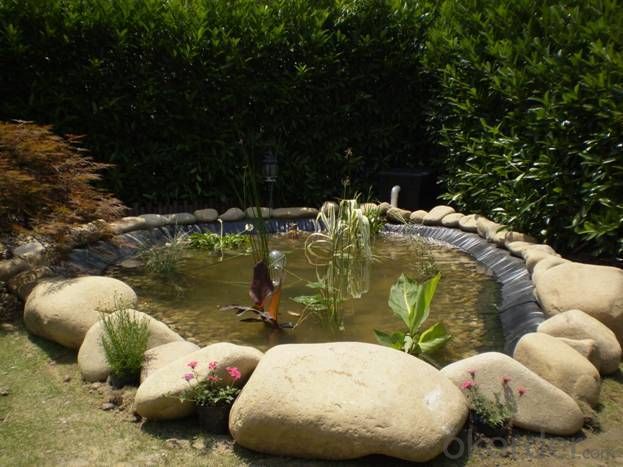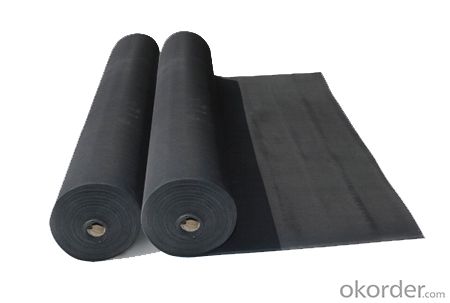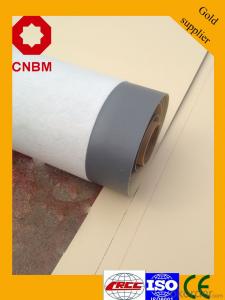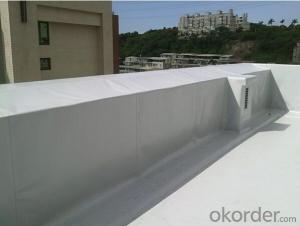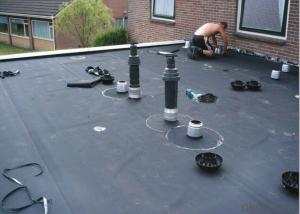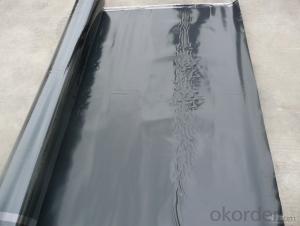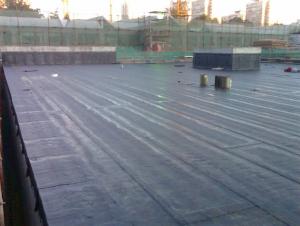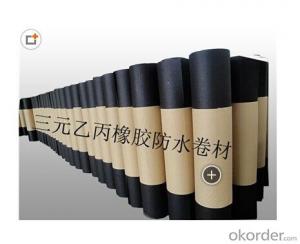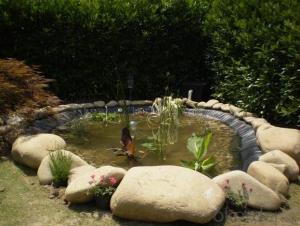EPDM Rubber Material Waterproof Membrane for Topping
- Loading Port:
- Shanghai
- Payment Terms:
- TT OR LC
- Min Order Qty:
- 50000 m²
- Supply Capability:
- 5000000 m²/month
OKorder Service Pledge
OKorder Financial Service
You Might Also Like
EPDM Rubber Material Waterproof Membrane for Topping
Description Of EPDM Rubber Material Waterproof Membrane for Topping:
This waterproof coiled material is of high elasticity with best performance among high polumer waterproof coiled material in the world.It is also the most typical one in the world.Waterproof coiled material made of ternary ethylene-propylene rubber is produced with the use of the most advanced contiuous extrusion and vulcanization technology and related equipments which are specially designed for production of such product.It is good in compactness,without bubble and performance difference in length and breadth,perfomances reach or exceed the demands of GB18173.1-2000 standard.
Main Features of EPDM Rubber Material Waterproof Membrane for Topping:
1.EPDM waterproof membrane for bridge engineering waterproof
2.EPDM waterproof membrane for water conservancy projects ,such as river bank,lake dam seepage.
3.EPDM waterproof membrane for the municipal engineering.
4.EPDM waterproof membrane for aquaculture.
Specifications of EPDM Rubber Material Waterproof Membrane for Topping:
| Number | Item | Unit | Value | |
| 1 | Size Variation | Thichness | % | ±10 |
| Width | % | ±1 | ||
| Length | % | Allowed negative | ||
| 2 | Breaking tensile strength at normal temperature | Mpa | ≥7.5 | |
| Breaking tensile strength at 70°C | Mpa | ≥2.3 | ||
| 3 | Breaking elongation at normal temperature | % | ≥450 | |
| Breaking elongation at -20°C | % | ≥200 | ||
| 4 | Tear strength | KN/m | ≥25 | |
| 5 | Impermeability(30min) | * | 0.3Mpa no leakage | |
| 6 | Bending at low tempreture | °C | ≤-40 | |
| 7 | Stretch tensor at heating | Elongate | mm | ≤2 |
| Shrink | mm | ≤4 | ||
| 8 | Air oven aging(80°C×168h) | Tensile strength at break retained | % | ≥80 |
| Elongation at break retained | % | ≥70 | ||
| 9 | Anti-alkali | Tensile strength at break retained | % | ≥80 |
| Elongation at break retained | % | ≥80 | ||
| 10 | Nuture weathing at manual simulation | Tensile strength at break retained | % | ≥80 |
| Elongation at break retained | % | ≥70 | ||
Applications of EPDM Rubber Material Waterproof Membrane for Topping:
Widely used in roofs, basement, toilet ,swimming pool, and all kinds of industry and civil building waterproofing, reservoir, vivicism, bridge, underground, tunnel and dam waterproofing ,especially to the keystone waterproofing projects which is durability, high corrosion resistance and easy deformation.

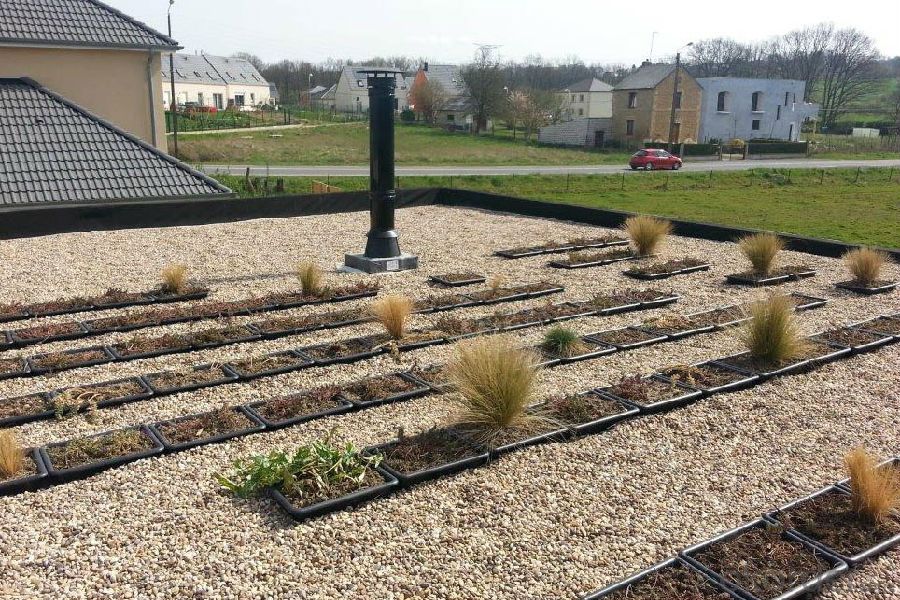

IMages of EPDM Rubber Material Waterproof Membrane for Topping:
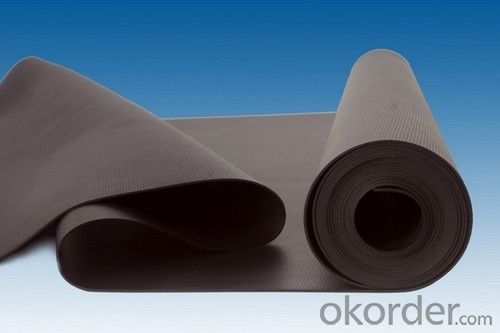
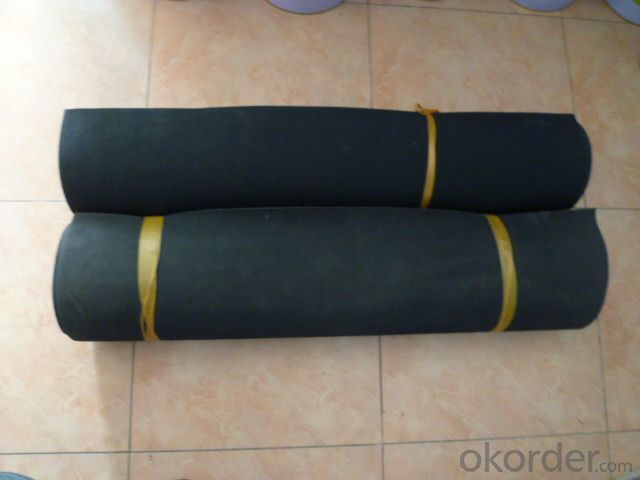


FAQ of EPDM Rubber Material Waterproof Membrane for Topping:
1. What are we supplying?
We are specialized in producing Colorful Asphalt Roof Shingle, SBS/APP modified bitumen waterproof membrane, Self adhesive bitumen waterproof membrane, PVC waterproofing membrane, EPDM rubber roofing membrane, Single Component Polyurethane Waterproof Coating, and Spray Polyurea Waterproof Coating
.
2. How Many years experience do we have?
We have been exported to more than 20 countries in the past 15 years.
3. How long do we usually reply your request?
We always reply our customer within 24 hours.
- Q: Can a waterproofing membrane be used on roofs with slope?
- Yes, a waterproofing membrane can be used on roofs with slope. In fact, it is commonly used on sloped roofs to provide an additional layer of protection against water intrusion. The membrane is typically installed beneath the roofing materials and acts as a barrier to prevent water from seeping into the roof structure. This is especially important on sloped roofs where water runoff is more rapid and can potentially result in leaks or damage. The waterproofing membrane is designed to be flexible and can accommodate the slope of the roof without compromising its effectiveness. Additionally, the membrane can also help to improve the overall durability and lifespan of the roof by preventing moisture-related issues such as rot or mold growth.
- Q: Does a waterproofing membrane require any special considerations for installation in seismic zones?
- Yes, a waterproofing membrane does require special considerations for installation in seismic zones. Seismic activity can cause significant ground movement and structural vibrations, which can potentially compromise the integrity of the membrane. Therefore, it is crucial to select a membrane that is specifically designed and tested to withstand seismic conditions. Additionally, proper installation techniques and materials, such as reinforced membranes and flexible adhesives, should be used to ensure the membrane remains intact during seismic events.
- Q: Can a waterproofing membrane be walked on?
- Walking on a waterproofing membrane is possible, but it depends on the type of membrane and its intended use. Some waterproofing membranes, like those used in roofing, are designed to withstand foot traffic without damage. These membranes are durable and can be walked on during installation and maintenance. However, it is crucial to follow the manufacturer's guidelines to ensure the membrane remains intact and provides effective waterproofing. On the other hand, certain types of below-grade waterproofing membranes may not be suitable for walking on as it could compromise their performance. It is advisable to consult a professional or refer to the manufacturer's instructions to determine if walking on a specific waterproofing membrane is safe and appropriate.
- Q: How does a waterproofing membrane handle movement of a building due to settling or seismic activity?
- The primary purpose of a waterproofing membrane is to adapt to a building's movements resulting from settling or seismic activity. By offering a pliable and resilient barrier, it effectively expands and contracts alongside the building, effectively preventing water infiltration. When a building settles or experiences seismic activity, it may undergo significant structural shifts. These shifts can result in cracks, displacements, or alterations in the building's foundation, walls, or floors. In the absence of adequate waterproofing, water can infiltrate through these cracks or gaps, leading to water damage, mold growth, and structural degradation. To address this issue, waterproofing membranes are typically fabricated using materials that possess exceptional elongation and recovery properties. Elongation pertains to the membrane's capacity to stretch without tearing, while recovery refers to its ability to return to its original shape after being stretched. This flexibility permits the membrane to synchronize its movements with the building, rather than resisting or fracturing under stress. Furthermore, waterproofing membranes are installed in a manner that accommodates horizontal and vertical movement. They are often applied in multiple layers, with overlapping seams, to establish an uninterrupted barrier. This layered approach enables the membrane to adapt and align with any potential shifts or settlements in the building. In regions prone to seismic activity, additional measures may be implemented to fortify the waterproofing system. These measures can involve using specialized membranes with heightened elongation and recovery properties or incorporating reinforcement elements such as fabric or mesh to enhance the membrane's ability to handle movement. In conclusion, a waterproofing membrane is specifically engineered to manage a building's movement caused by settling or seismic activity. Its adaptability, elongation, recovery properties, and appropriate installation techniques enable it to accommodate the building's movements while sustaining a watertight barrier.
- Q: Can waterproofing membranes be used for planter boxes?
- Yes, waterproofing membranes can be used for planter boxes. Waterproofing membranes are designed to prevent water from penetrating surfaces, and can be applied to various materials such as wood, concrete, or metal. By applying a waterproofing membrane to the inside of a planter box, it can help to protect the material from water damage, prolonging the lifespan of the planter box. This is especially beneficial for wooden planter boxes, as the membrane can prevent the wood from rotting or deteriorating over time. Additionally, the waterproofing membrane can help to retain moisture within the planter box, preventing water from seeping out and ensuring that the plants receive sufficient water for healthy growth. Overall, using waterproofing membranes for planter boxes can help to improve their durability and performance, making them a popular choice for both indoor and outdoor gardening.
- Q: Can a waterproofing membrane be used in planter boxes or raised beds?
- To prevent water leakage and protect the structures around, one can make use of a waterproofing membrane in planter boxes or raised beds. The materials typically used for such membranes are rubber, PVC, or polyethylene, creating a barrier between the soil and the surrounding area. This barrier aids in retaining moisture within the planter box or raised bed, stopping water from seeping into the ground and potentially causing harm to the foundation or nearby structures. Additionally, the use of a waterproofing membrane also helps in preventing the leaching of chemicals or fertilizers from the soil, thereby enhancing the overall quality of the planting environment. However, it is crucial to ensure proper drainage in planter boxes or raised beds to avoid waterlogging and root rot.
- Q: Can a waterproofing membrane be used on nickel surfaces?
- Yes, a waterproofing membrane can be used on nickel surfaces. Waterproofing membranes are commonly used in construction and building projects to protect surfaces from water damage and moisture intrusion. They create a barrier that prevents water from penetrating through the surface and causing damage. Nickel surfaces, like any other metal surfaces, can be susceptible to corrosion and damage from water exposure. By applying a waterproofing membrane, the nickel surface can be effectively protected from water and moisture, extending its lifespan and maintaining its integrity. However, it is important to ensure that the specific waterproofing membrane being used is suitable for application on nickel surfaces. Different membranes may have different compatibility requirements, so it is recommended to consult with the manufacturer or a professional to ensure proper application and compatibility.
- Q: Can a waterproofing membrane be used in conjunction with concrete repair or restoration?
- Yes, a waterproofing membrane can be used in conjunction with concrete repair or restoration. The membrane acts as an additional protective layer to prevent water penetration and enhance the durability and longevity of the repaired or restored concrete structure.
- Q: Are there any specific installation techniques for corners and edges when using a waterproofing membrane?
- Yes, when installing a waterproofing membrane on corners and edges, it is important to follow specific techniques. First, ensure that the membrane extends beyond the corner or edge by at least 6 inches to provide adequate coverage. Next, carefully fold and crease the membrane to create a tight seal around the corner or edge. Use a heat gun or adhesive to secure the folded membrane in place. Additionally, apply a layer of sealant or waterproofing tape over the folded membrane to further reinforce the corner or edge. These techniques help prevent water penetration and ensure effective waterproofing in these vulnerable areas.
- Q: Can a waterproofing membrane be used on gypsum block surfaces?
- Yes, a waterproofing membrane can be used on gypsum block surfaces. Gypsum blocks are porous materials that can absorb moisture and are not naturally waterproof. Applying a waterproofing membrane can help to prevent water infiltration, moisture damage, and mold growth on the gypsum block surfaces. It creates a barrier that repels water and prevents it from seeping into the material. However, it is important to ensure that the waterproofing membrane is suitable for use on gypsum blocks and is compatible with the specific type of gypsum block being treated. Additionally, proper surface preparation and application techniques should be followed to ensure the effectiveness and longevity of the waterproofing membrane.
Send your message to us
EPDM Rubber Material Waterproof Membrane for Topping
- Loading Port:
- Shanghai
- Payment Terms:
- TT OR LC
- Min Order Qty:
- 50000 m²
- Supply Capability:
- 5000000 m²/month
OKorder Service Pledge
OKorder Financial Service
Similar products
Hot products
Hot Searches
Related keywords







